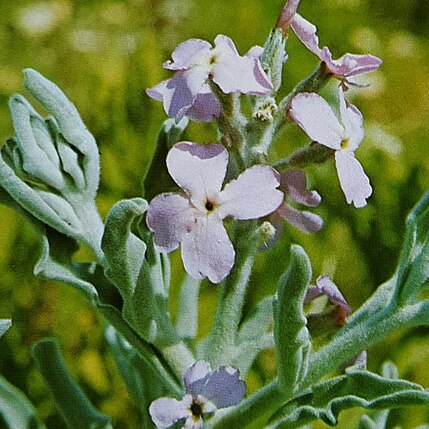Herbs annual or perennial. Trichomes eglandular, stalked or sessile, stellate or dendritic, rarely forked or simple, sometimes mixed with glandular, multicellular, multiseriate ones. Basal leaves petiolate, rosulate or not, simple, entire, dentate, or pinnatisect. Cauline leaves petiolate or sessile and not auriculate, entire, dentate, or pinnatisect. Racemes ebracteate, elongated in fruit. Fruiting pedicels erect or divaricate. Sepals oblong or linear, connivent, erect, base of lateral pair strongly saccate. Petals yellowish green, white, pink, purple, or brown, much longer than sepals, clawed; blade broadly obovate, spatulate, oblong, or linear, flat or involute, crisped or not, apex obtuse or emarginate. Stamens 6, strongly tetradynamous; filaments not dilated at base; anthers oblong or linear, obtuse at apex. Nectar glands lateral, 4, when 1 on each side of lateral stamen, or 2, when semiannular and intrastaminal; median glands absent. Ovules (5-)15-60 per ovary. Fruit dehiscent siliques, linear, terete or latiseptate, sessile; valves with a prominent midvein, often torulose; replum rounded; septum complete, often opaque, veinless; style obsolete or up to 3 mm; stigma conical, 2-lobed, lobes prominent, connivent, free or connate, decurrent, unappendaged or with 2 or 3 hornlike appendages. Seeds uniseriate, narrowly winged or wingless, oblong, ovate, or orbicular, flattened; seed coat minutely reticulate, not mucilaginous when wetted; cotyledons accumbent.
Annual herbs to subshrubs, ± branched, with often dense greyish or whitish tomentum of branched and sometimes also glandular hairs. Leaves undivided to pinnatifid. Racemes ebracteate, with rather few showy flowers, elongate in fruit. Sepals erect, the inner saccate. Petals purplish, violet or sordid white, distinctly clawed. Stamens 6, distinctly tetradynamous; filaments free, the median dilated, the lateral linear; anthers acuminate. Nectaries as prominent horseshoe-shaped glands outside each lateral stamen-base, often continuing outside the base of the median stamens (sometimes forming a ring). Ovary linear; stigma practically sessile, conoidal with decurrent narrow lobes, bifid; ovules numerous. Fruit a siliqua, linear, terete or dorso-ventrally compressed, sometimes torulose, without transverse septa; style often 2-horned. Seeds uniseriate, suborbicular, compressed, often winged.
Annual or perennial taprooted herbs, often woody below. Hairs dense, branched. Stems decumbent to erect, leafy above. Lvs entire to sinuate to pinnatifid, usually narrow. Racemes ebracteate. Sepals erect, the inner usually saccate. Petals purple, pink or white. Stamens 6; filaments of inner stamens branched. Lateral nectaries 4, paired at bases of lateral stamens; median nectaries 0. Stigma sessile, of 2 erect lobes with dorsal swellings or horn-like processes. Silique linear, cylindric or flattened, dehiscent; valves conspicuously 1-veined; beak 0. Seeds circular, compressed, winged or not, in 1 row per locule.
Annual or perennial herbs. Sepals dimorphic. Petals long-clawed. Stamens 6, spreading. Stigma sessile, bilobed, each lobe erect with dorsal swelling or horn-like process. Siliqua dehiscent; valves with midvein, pubescent. Seeds in 1 row per locule. Radicle accumbent.

